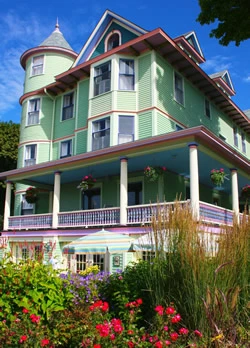9 Iconic Historic Attractions to Discover on Mackinac Island
Introduction
Mackinac Island is a place where history lives and breathes. This Michigan treasure is well-known for its car-free streets and Victorian beauty, drawing tourists from all over the world. Stepping onto Mackinac feels like entering a different era, where life moves at a relaxed pace. Nine famous historical sites that make this island genuinely remarkable are covered in this blog series. Each site offers unique stories and timeless beauty.
Fort Mackinac
Fort Mackinac stands as a symbol of strength and history. Built in 1780 by the British, it overlooks the beautiful harbor. This stone fortress has seen two centuries of American and British history. It has been superbly preserved and was crucial to the War of 1812. Visitors can step back in time with reenactments and tours. Soldiers in 19th-century uniforms bring history to life here. The fort also offers impressive views of Lake Huron. For a more tranquil atmosphere and fewer crowds, schedule your visit for the morning.
Mackinac Island State Park
Mackinac Island State Park is Michigan’s first and occupies almost 80% of the island. Established in 1895, it preserves both nature and history. The park offers stunning trails, scenic overlooks, and historical sites. The famous Arch Rock, a naturally occurring limestone bridge, is one of the park’s main attractions. Rising over 140 feet, it offers breathtaking lake views. Alongside nature, visitors will find markers and monuments reflecting Mackinac’s past. The park is an outdoor museum, blending natural beauty with history. Exploring it on foot or bike enhances the island experience.
Grand Hotel
Mackinac Island’s crown jewel is the Grand Hotel. Built in 1887, it boasts the world’s longest porch, stretching over 660 feet. The hotel’s bright white exterior and colorful awnings are unforgettable. It is renowned for entertaining well-known people like Mark Twain and is a symbol of elegance and grandeur. Visitors can stroll its porch, sip tea in the afternoon, or enjoy breathtaking views. The Grand Hotel is worth seeing even if you are not staying there. The experience is invaluable, although there is a little admission fee. Dress codes apply in the evening, adding a touch of old-world charm.
Historic Downtown Mackinac
The downtown area of Mackinac Island transports visitors back in time. With charming, Victorian-era buildings and family-owned shops, it feels like time stopped here. The island’s historic downtown area offers a mix of boutiques, eateries, and museums. Each building holds a piece of Mackinac’s history, reflecting its trading post origins. Cobblestone streets guide visitors through spots that have remained unchanged for decades. One must-visit spot is the Mackinac Island Historic Museum. Here, visitors can explore artifacts and learn about the island’s unique past. Walking downtown feels like stepping back in time with modern comforts. Spend a relaxed afternoon strolling, shopping, and enjoying this special place.
Mission Church
Mission Church is a peaceful slice of history on Mackinac Island. Built in the early 19th century, it’s Michigan’s oldest surviving church. Originally established by missionaries, it holds deep ties to the island’s early settlers. Its design is simple but stands out for its beauty and resilience. The church has witnessed many seasons and remains in excellent condition. Inside, visitors will find modest wooden pews and large, bright windows. It provides a peaceful area for introspection and reconnection with Mackinac’s history. The Mission Church is open to visitors, allowing them a glimpse into the island’s spiritual roots. Visiting here is a must for history lovers and those seeking peace.
The Richard & Jane Manoogian Mackinac Art Museum
Set within the Mackinac Island State Park, the Manoogian Art Museum is a cultural gem. It celebrates the island’s rich history and artistic inspiration. This museum, which is housed in a historic building, features art influenced by the islands as well as Native American artifacts. The exhibits showcase a mix of early island life and contemporary art. Highlights include traditional Ojibwe crafts, historic photos, and modern paintings. The beauty and essence of Mackinac are captured in these works, which span generations. For anyone who enjoy both art and history, the museum is ideal. Visitors can take in beautiful artwork while learning about Mackinac’s cultural influences. Open seasonally, it’s an enriching stop for travelers exploring the island’s creative side.
Biddle House
The Biddle House is a time capsule of Mackinac’s early days. Built in the 18th century, it’s one of the island’s oldest structures. This cozy, historic home gives insight into life in the early 1800s. The Biddle family, fur traders, lived here, contributing to the island’s economy. Inside, exhibits show domestic life during Mackinac’s fur trade era. Visitors can see simple furnishings and cooking tools from centuries ago. An uncommon window into early settlers’ lives is offered by the Biddle House. It’s a handy place to halt on a walking tour because it’s close to other historic places. For those curious about daily life long ago, Biddle House is a must-see.
Sainte Anne’s Catholic Church
Sainte Anne’s Church is a true landmark with deep island roots. It is among the oldest Catholic churches in America, having been established in the 1600s. The architecture of the church, which was constructed by French missionaries, is indicative of that time period. Its wooden structure and stained glass windows are especially beautiful. The grounds, which include a historic cemetery, are open for exploration by guests. Many early residents are buried here, making it a place of reflection. The church is still active, welcoming visitors for services and tours. Sainte Anne’s embodies the island’s faith, history, and community. Attending a service or exploring the peaceful grounds is a memorable experience.
Skull Cave
Skull Cave is a natural wonder with a haunting past. This small limestone cave dates back centuries and is part of Native American legend. The Ojibwe people used it as a sacred place and later as a refuge. Skull Cave’s name comes from the bones once found inside, adding mystery to its story. During wartime, fur traders often used it as a hiding place. Today, the cave is a popular historic and natural site. A short hike leads to the cave, surrounded by scenic views. History lovers and nature enthusiasts alike will appreciate this unique landmark. Skull Cave is a blend of nature, history, and mystery that captures Mackinac’s spirit.
Conclusion
Mackinac Island offers a rare blend of history and charm. Each landmark tells its own unique story, inviting visitors to step back in time. From forts to caves and churches, every site has something special. Exploring these attractions makes any visit unforgettable and enriching. Mackinac’s history, preserved so well, brings the past to life. Staying at Inn on Mackinac enhances this experience with comfort and convenience. Embrace the magic of Mackinac and make memories to last a lifetime. The history of this island awaits your discovery.
Category: Mackinac Island


